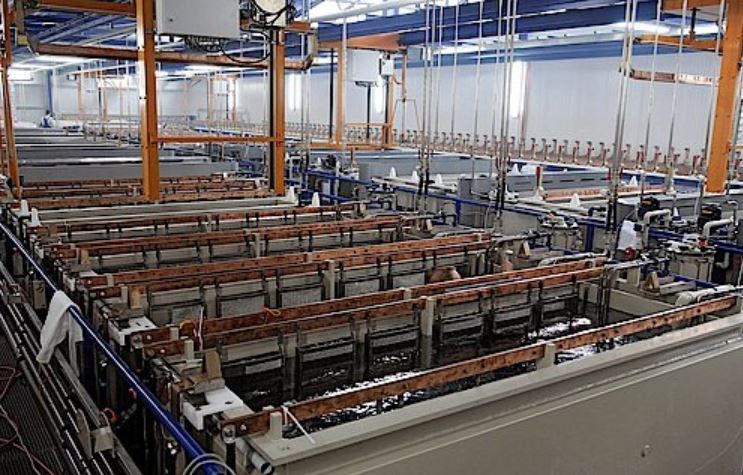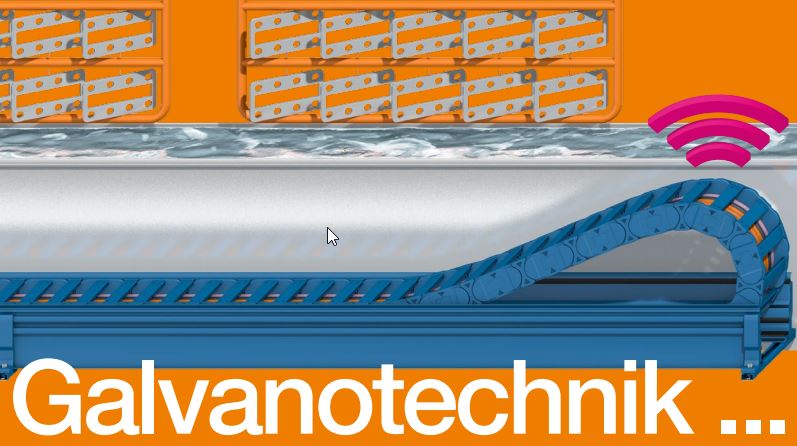Pretty corrosive!
pwirth | 9. September 2020
The harsh environment of electroplating plants makes cables and energy supply systems a challenge. The answer from igus: energy chains and guide troughs made of the chemical-resistant, high-performance polymer igumid EG+ and tough chainflex cables.
The rim of a sports car flashes in the sun. No wonder, it is covered with chrome plating. The door handle in the living room shines in gold, it is refined with a brass coating. Electroplating plants are used to apply such coatings. They usually work with an electrolytic process. The workpiece is placed in an electrolytic bath at the negative pole (cathode). At the positive pole (anode) is a metal like chrome, brass or copper.
As soon as a voltage is applied to the poles, the current separates metal ions from the consumable electrode. These are then deposited on the workpiece.

Innumerable products are finished in this way. According to the Federal Environment Agency, the 2,000 electroplating companies in Germany generate an annual turnover of up to six billion euros. Sounds like few problems there. However, it is not always easy to keep the plants in good shape.
The problem: chemicals make cables brittle
Plant components are subject to high stress in many electroplating plants. This is illustrated by energy supply systems. An example: large plants work with indoor cranes in which the trolley moves over 20 metres and more. It immerses workpieces in several baths, station by station – including preparation baths and the actual electroplating bath. Power and data cables of the crane system must follow the movement of the trolley, often inserted in energy chains, in other cases suspended in festooning systems.
The problem: chemical substances used in electroplating can wear down cables and energy chains. This results in a high maintenance effort and expensive system failures. But this does not have to be the case, because we develop components that are prepared for high loads.
The solution: energy chains and guide troughs made of chemical-resistant, high-performance polymer
To make electroplating systems more fail-safe, we have developed igumid EG+ – a high-performance polymer for energy chains and trough systems in which the e-chain runs. The polymer is characterised by a high density and low water absorption. This makes the material resistant to aggressive chemicals. The polymer can also be used at high temperatures of up to +100°C. Thanks to these specifications, e-chains can survive many hundreds of thousands of strokes in electroplating plants without material fatigue.
A further advantage: in order to have protection against the effects of chemicals, machine builders previously had to use trough systems made of expensive stainless steel materials such as 304 SS or 316 SS for e-chains. This investment is no longer necessary. Troughs of the guidelite Plus series made of igumid EG+ are around 58% more cost-effective than stainless steel guide troughs. And significantly lighter. One metre weighs 1.8 kilograms, while one metre of stainless steel trough weighs 7.5 kilograms.

https://www.igus.eu/info/energychain-system-for-galvanizing?L=en
Chemical-resistant cables round off the solution
Of course, the cables themselves must be resistant to chemicals, not only e-chains and guide troughs. chainflex cables are suitable for use in electroplating technology – including control cables, servo cables and motor cables, for which we offer an above-average 36-month guarantee. The cables are resistant to chemicals and abrasion. They function perfectly over a long period of time, even with long travels and the most extreme environmental conditions.
On request, we can also harness the e-chains with chainflex cables. This ensures that all materials – from the connectors to the jacket of the cables – are perfectly matched and achieve maximum service life. To further increase safety, the use of smart plastics is another option. The e-chains, equipped with radio sensors, initiate an automatic stop of plant in case of a mechanical defect. And prevent expensive consequential damage. The sensors also continuously report the condition of individual components so that operators can plan their maintenance operations better.
